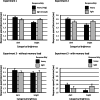Heaviness-brightness correspondence and stimulus-response compatibility
- PMID: 31898071
- PMCID: PMC7297857
- DOI: 10.3758/s13414-019-01963-6
Heaviness-brightness correspondence and stimulus-response compatibility
Abstract
Cross-sensory correspondences can reflect crosstalk between aligned conceptual feature dimensions, though uncertainty remains regarding the identities of all the dimensions involved. It is unclear, for example, if heaviness contributes to correspondences separately from size. Taking steps to dissociate variations in heaviness from variations in size, the question was asked if a heaviness-brightness correspondence will induce a congruity effect during the speeded brightness classification of simple visual stimuli. Participants classified the stimuli according to whether they were brighter or darker than the mid-gray background against which they appeared. They registered their speeded decisions by manipulating (e.g., tapping) the object they were holding in either their left or right hand (e.g., left for bright, right for dark). With these two otherwise identical objects contrasting in their weight, stimuli were classified more quickly when the relative heaviness of the object needing to be manipulated corresponded with the brightness of the stimulus being classified (e.g., the heavier object for a darker stimulus). This novel congruity effect, in the guise of a stimulus-response (S-R) compatibility effect, was induced when heaviness was isolated as an enduring feature of the object needing to be manipulated. It was also undiminished when participants completed a concurrent verbal memory load task, countering claims that the heaviness-brightness correspondence is verbally mediated. Heaviness, alongside size, appears to contribute to cross-sensory correspondences in its own right and in a manner confirming the far-reaching influence of correspondences, extending here to the fluency with which people communicate simple ideas by manipulating a hand-held object.
Keywords: Brightness; Cross-sensory correspondences; Heaviness; Stimulus-response compatibility.
Figures



Similar articles
-
The size-brightness correspondence: evidence for crosstalk among aligned conceptual feature dimensions.Atten Percept Psychophys. 2015 Nov;77(8):2694-710. doi: 10.3758/s13414-015-0977-3. Atten Percept Psychophys. 2015. PMID: 26294420
-
Cross-Sensory Correspondences: Heaviness is Dark and Low-Pitched.Perception. 2017 Jul;46(7):772-792. doi: 10.1177/0301006616684369. Epub 2016 Dec 20. Perception. 2017. PMID: 28622755
-
Cross-sensory mapping of feature values in the size-brightness correspondence can be more relative than absolute.J Exp Psychol Hum Percept Perform. 2016 Jan;42(1):138-50. doi: 10.1037/xhp0000128. Epub 2015 Aug 31. J Exp Psychol Hum Percept Perform. 2016. PMID: 26322684
-
Auditory stimulus-response compatibility: is there a contribution of stimulus-hand correspondence?Psychol Res. 2000;63(2):148-58. doi: 10.1007/pl00008173. Psychol Res. 2000. PMID: 10946588 Review.
-
On the Relative Nature of (Pitch-Based) Crossmodal Correspondences.Multisens Res. 2019 Jan 1;32(3):235-265. doi: 10.1163/22134808-20191407. Multisens Res. 2019. PMID: 31059485 Review.
Cited by
-
Crossmodal correspondences between visual and speech angularity and tactile jaggedness of response key.Sci Rep. 2024 Nov 13;14(1):27806. doi: 10.1038/s41598-024-79400-4. Sci Rep. 2024. PMID: 39537859 Free PMC article.
-
Crossmodal Associations with Olfactory, Auditory, and Tactile Stimuli in Children and Adults.Iperception. 2021 Dec 6;12(6):20416695211048513. doi: 10.1177/20416695211048513. eCollection 2021 Nov. Iperception. 2021. PMID: 34900211 Free PMC article.
References
-
- Baneberry, Y. (2007). Bittersweet Nightshade. Xlibris. p. 75.
-
- Bates D., Maechler, M., Bolker, B. & Walker, S. (2014). lme4: Linear mixed-effects models using Eigen and S4. R package version 1.1-7, <URL:http://CRAN.R-project.org/package=lme4>.
-
- Becker L, van Rompay TJL, Schifferstein HNJ, Galetzka M. Tough package, strong taste: The influence of packaging design on taste impressions and product evaluation. Food Quality and Preference. 2011;22:17–23.
-
- Bomba PC, Siqueland ER. The nature and structure of infant form categories. Journal of Experimental Child Psychology. 1983;35:294–328.
-
- Bradford, M. (2015). Button Hill. Victoria, British Columbia: ORCA Book Publishers. p. 24.
MeSH terms
LinkOut - more resources
Full Text Sources
Research Materials

